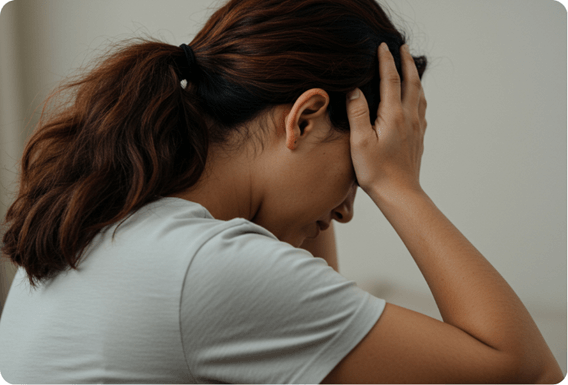Table of Contents
Even occasional anxiety is rooted in how your body’s autonomic nervous system (ANS) responds to stress. This system, made up of the sympathetic (“fight-or-flight”) and parasympathetic (“rest-and-digest”) branches, controls how your body reacts to challenges. When anxiety pops up, your sympathetic system can take over, causing racing thoughts, a pounding heart, or shallow breathing.
The good news? Research shows that stimulating the vagus nerve, especially through simple breathwork—can help calm the nervous system, restore balance, and make those anxious moments feel more manageable.
Anxiety and the Vagus Nerve
The vagus nerve, the tenth cranial nerve, is a central component of the parasympathetic nervous system, often referred to as the "rest-and-digest" system. It exerts widespread influence over visceral functions, including heart rate, respiration, and digestion, as well as neuroendocrine and immune responses.
In anxiety disorders, impaired vagal tone, reflected in decreased heart rate variability (HRV), is commonly observed. This reduced vagal activity contributes to an overactive sympathetic response, characterized by increased heart rate, rapid breathing, and heightened arousal. Furthermore, studies have linked anxiety to alterations in neurotransmitter systems, including reduced gamma-aminobutyric acid (GABA) levels, a key inhibitory neurotransmitter known for its calming effects.
Breathwork as a Neuromodulator: The Vagus Nerve Connection
Vagus nerve stimulation, 0.1 Hz breathing, also known as resonance breathing or coherent breathing, refers to a specific breathing pattern characterized by approximately 6 breaths per minute. This slow, rhythmic breathing pace has been shown to be particularly effective in activating the vagus nerve and promoting a relaxation response.
By stimulating the vagus nerve, 0.1 Hz breathing helps to:
- Reduce sympathetic activity: It counteracts the "fight-or-flight" response associated with anxiety, lowering heart rate and promoting calmness. It actually triggers your parasympathetic response and releases neurotransmitters like acetylcholine.
Acetylcholine acts as a natural tranquilizer in your body. - Increase heart rate variability (HRV): This indicates improved balance in the autonomic nervous system, enhancing stress resilience. A higher HRV signifies a greater influence of the parasympathetic system, which promotes calmness.
- Boost GABA activity: Studies suggest that 0.1 Hz breathing may increase levels of GABA, a neurotransmitter that promotes relaxation. GABA helps to maintain a balance between the excitatory and inhibitory functions of the nervous system.
Incorporating 0.1 Hz breathing into your daily routine can be a valuable tool for managing symptoms, maintain emotional balance, and enhancing overall well-being.
Breathwork and Anxiety: Evidence-Based Benefits
A growing body of research supports the efficacy of breathwork in managing various anxiety disorders:
- Generalized Anxiety Disorder (GAD): Regular breathwork practice has been shown to reduce worry, tension, and physiological arousal in individuals with GAD.
- Panic Attack: Controlled breathing techniques can help interrupt the escalating panic cycle by slowing heart rate and promoting relaxation.
- Post-Traumatic Stress Disorder (PTSD): Breathwork can aid in regulating the hyperarousal state often experienced by individuals with PTSD, reducing flashbacks and nightmares.
- Social Anxiety Disorder: Breathwork can help manage the physiological symptoms, such as rapid heartbeat and sweating, allowing for greater ease in social situations.
Optimizing Breathwork for Anxiety Management
While various breathing techniques exist, certain parameters enhance VNS and maximize stress-reducing effects:
- Respiratory Rate: Aim for a slow pace of 6-8 breaths per minute. Inhale with your nose and exhale with your mouth. The goal is to get to the 0.1Hz frequency to boost acetylcholine.
- Inhalation/Exhalation Ratio: Prolong the exhalation phase with pursed lips. Make sure you inhale enough to get to the end of your prolonged exhalation.
- Mindful Focus: Maintain attention on the breath and respect the pace of breathing to achieve six breaths a minute.
Consistency is key:
Regular practice, even for short periods, is more beneficial than infrequent, long sessions. You should aim for daily practice, even if it's just for 5-10 minutes it will build resiliency after few weeks.
When to Practice:
- During an attacks: Breathwork can be used to calm the nervous system during acute anxiety attacks.
- Preventative practice: Regular breathwork can help to reduce overall anxiety levels and build resilience.
- Before bed: Breathwork can promote relaxation and improve sleep quality.
- Throughout the day: Short breathwork breaks can help to manage stress and maintain calmness throughout the day.
Integrating Breathwork into a Comprehensive Treatment Plan
Breathwork offers a valuable complementary approach, but it's essential to integrate it within a comprehensive treatment plan tailored to your individual needs. This may include:
- Cognitive Behavioral Therapy (CBT): To identify and modify unhelpful thought patterns and behaviors.
- Medication: In some cases, medication may be necessary to manage severe symptoms.
- Lifestyle modifications: Getting enough sleep, regular exercise, and a healthy diet low on sugar can improve mood, boost energy levels, and promote emotional balance.
By harnessing the power of breathwork and its influence on the vagus nerve, you can actively participate in rewiring your nervous system response and cultivating a state of greater calm and resilience.
Ready to experience the transformative power of 0.1 Hz breathwork?Discover
Disclaimer: This blog post is intended for informational purposes only and should not be considered medical advice. Always consult with a qualified healthcare professional for any health concerns or before making any decisions related to your health or treatment.
References
Streeter, C. C., et al. (2019). Effects of diaphragmatic breathing on GABA levels in healthy adults: a pilot study. Alternative Therapies in Health and Medicine , 25(5), 40–43.
Chalmers, J. A., Quintana, D. S., Abbott, M. J., & Kemp, A. H. (2014). Anxiety disorders are associated with reduced heart rate variability: a meta-analysis. 1 Frontiers in Psychiatry, 5, 80. 2
Brown, R. P., & Gerbarg, P. L. (2005). Sudarshan Kriya yogic breathing in the treatment of stress, anxiety, and depression: Part I—neurophysiologic model. The Journal of Alternative and Complementary Medicine, 11(1), 189-201.
Gerritsen, L., & Band, G. P. (2018). Breath of life: the respiratory vagal stimulation model of contemplative activity. Frontiers in Human Neuroscience, 12, 397.
Ma, X., et al. (2017). The effect of diaphragmatic breathing on attention, negative affect and stress in healthy adults. Frontiers in Psychology, 118(1), 3112-3120.
Vestergaard-Poulsen, P., et al. (2009). Long-term meditation is associated with increased gray matter density in the brain stem. Neuroreport, 20(2), 170-174.
FAQs
How does breathwork help reduce anxiety?
Breathwork activates the parasympathetic nervous system, which counteracts the stress-driven sympathetic “fight-or-flight” response. Slow, controlled breathing can lower heart rate, reduce cortisol, and calm racing thoughts, helping you feel more grounded during anxious moments.
How does the nervous system respond to breathwork during anxiety?
Breathwork directly influences the autonomic nervous system (ANS), which controls your body’s stress response. Slow, rhythmic breathing signals the parasympathetic branch to activate, calming the heart, reducing tension, and countering the overactive sympathetic “fight-or-flight” response. Over time, regular practice improves nervous system flexibility, making it easier to manage both occasional and chronic anxiety.
What type of breathwork is most effective for anxiety?
Resonant or 0.1 Hz breathwork—about 6 breaths per minute—is particularly effective. Focusing on smooth, gentle inhalations and slightly longer exhalations helps stimulate the vagus nerve, promoting relaxation and restoring nervous system balance.
How quickly can breathwork help with anxiety?
Many people notice a calming effect within minutes. While short sessions can help immediately during an anxious moment, regular practice strengthens vagal tone and improves overall stress resilience over time.
Can breathwork help with chronic anxiety or panic attacks?
Yes. Breathwork can reduce the intensity and frequency of anxious episodes by training the nervous system to shift out of fight-or-flight mode. For chronic or severe anxiety, combining breathwork with professional guidance can provide the most effective results.




